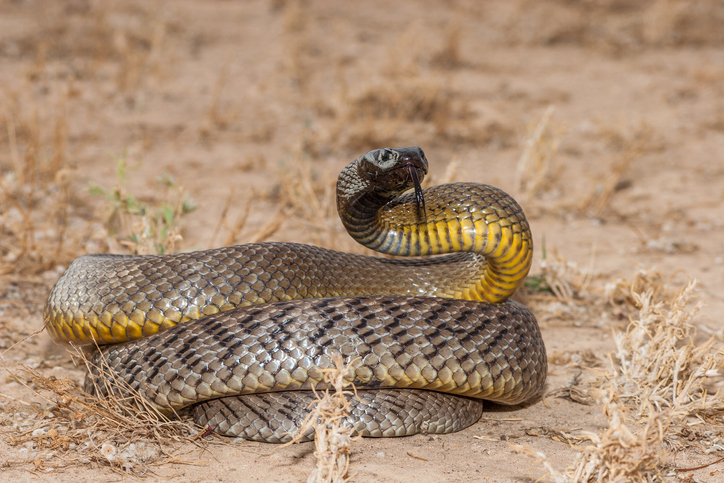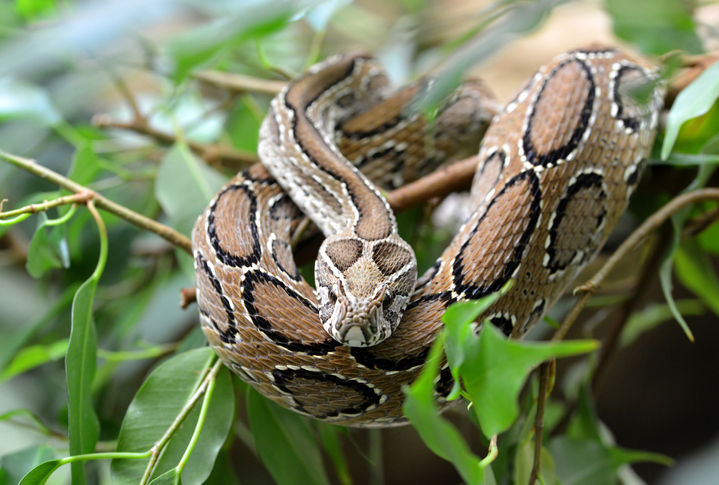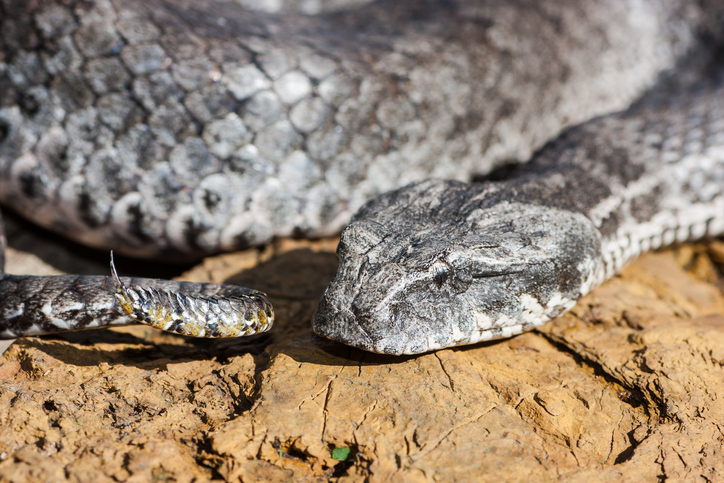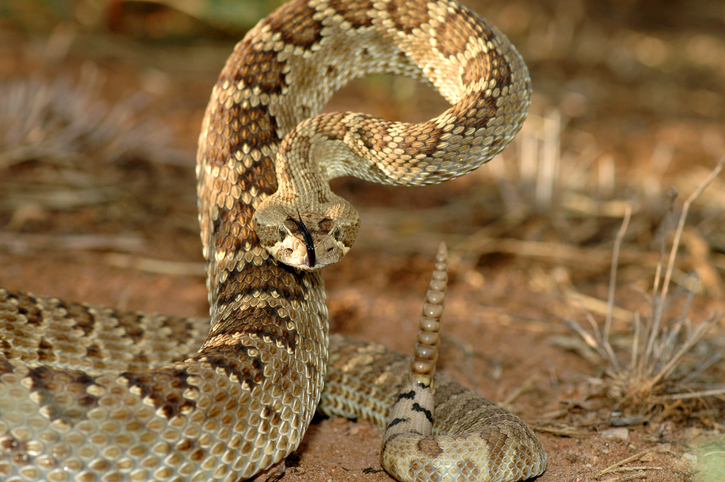10 of the World’s Deadliest Snakes
Most people in the world have a fear of snakes. Those with an abnormal fear have a whole fear named for them—“Ophidiophobia”. However, the fear seems perfectly rational seeing as how dangerous some of them can be. But a question begs to be asked— Are snakes really that dangerous? The simple answer is that while a majority of the snakes are harmless, we still need to maintain a distance. Bites from venomous or non-venomous snakes can be extremely painful. There are quite a few dangerous snakes in the world and it is always better to know what kind of snake you are dealing with before you decide your next step.
First, let’s get one thing straight—the term “poisonous snakes” is a misnomer, as poison and venom are different things. According to biologists, the term poisonous is applied when an organism releases toxins when they are eaten. The term venomous is applied when organisms bite or sting and inject their toxins through the bite. So, to say that the Black Mamba is one of the “most poisonous snakes in the world” would be incorrect. Instead, it’s one of the “most venomous snakes in the world”.
The second misconception is that while snakes are venomous and not poisonous, not all are venomous snakes.
1. The Deadliest Snake In The World, The Saw-Scaled Viper (Echis Carinatus)

Although its venom is not very potent, the Saw-Scaled Viper is considered as one of the world’s deadliest snakes as it believed to be responsible for more human fatalities than all other snakes put together. These snakes have a stout body with a pear-shaped head which is distinct from the neck. Adult Saw-Scaled Vipers range in length from 0.3 to 0.9 metre and they come in shades of brown, grey, or orange with darker dorsal blotches and lateral spots.
Unlike most snakes, this Viper moves sideways (sidewinding locomotion). They are nocturnal and feed on mammals, birds, other snakes, lizards, amphibians, scorpions and centipedes. They can be found in arid regions and dry savannahs north of the Equator across Africa, India, Sri Lanka, Pakistan, and the Middle East.
Saw-Scaled Vipers are considered to be one of deadliest snakes of the world because they are often found in populated areas and a lack of readily accessible antivenom in rural areas adds to their lethality. So clearly, the potency of the venom has no bearing on the list of dangerous snakes in the world.
Some fun facts about the saw-scaled viper:
- Saw-Scaled Vipers can live for up to 23 years.
- Up to 80 per cent of these adults climb up bushes and trees when it rains.
- In northern regions, they hibernate during winter.
2. The World’s Longest Venomous Snake, The King Cobra (Ophiophagus Hannah)
 In India, the King Cobra is not only revered and worshipped but also feared, as they are one of the most venomous snakes of India. In one bite, a King Cobra delivers a tremendous amount of neurotoxins that induces paralysis. They are so fearsome that they find themselves on almost all lists of top 10 dangerous snakes in the world. These snakes are dark olive or brown in colour with black bands and white and yellow crossbands with cream or pale yellow undersides. They measure up to 3 to 4 metres in length and have black heads with two crossbars near the snout and two behind the eyes. Young cobras are shiny black with narrow yellow bands.
In India, the King Cobra is not only revered and worshipped but also feared, as they are one of the most venomous snakes of India. In one bite, a King Cobra delivers a tremendous amount of neurotoxins that induces paralysis. They are so fearsome that they find themselves on almost all lists of top 10 dangerous snakes in the world. These snakes are dark olive or brown in colour with black bands and white and yellow crossbands with cream or pale yellow undersides. They measure up to 3 to 4 metres in length and have black heads with two crossbars near the snout and two behind the eyes. Young cobras are shiny black with narrow yellow bands.
Although they are shy and avoid confrontation with humans, King Cobras are some of the most dangerous snakes in the world when provoked. They are, however, very caring towards their offspring as they are the only snakes that build a nest for their eggs and guard them till they hatch. A female King Cobra is a very dedicated parent, an unusual trait among snakes. They primarily eat other snakes (including the venomous ones), however, when food is scarce they also eat lizards, birds, and rodents.
King Cobras are found in Bangladesh, Bhutan, Brunei, Cambodia, China, Hong Kong, India, Indonesia, Laos, Malaysia, Myanmar, Nepal, Philippines, Singapore, Thailand and Vietnam. A King Cobra’s venom is so strong that it can kill an elephant in just a few hours and can cause death in 50 to 60 per cent of untreated human cases.
Some fun facts about the King Cobra:
- King Cobras are monogamous, which means they mate with only one partner for life.
- The King Cobra’s generic name, Ophiophagus is derived from Greek and means “snake eater”.
- King Cobras have a slow metabolic rate and so, can go for months without food after a large meal.
3. A Snake With The Deadliest Venom In The World, The Inland Taipan (Oxyuranus Microlepidotus)

Also known as the “fierce snake”, the Inland Taipan is one of the world’s most venomous snakes. A bite from this variety of Taipan often causes paralysis of the victim’s nervous system and clots the blood. The Inland Taipan, one of three types of Taipans (Coastal, Inland and Central Ranges), is dark tan in colour, ranging from a rich, dark hue to a brownish light-green, depending on the season. This variety of Taipan is smaller than the coastal variety and can grow up to 1.7 metres in length.
A solitary creature, these snakes primarily come out during the day. They are most active early in the morning and generally spend their time looking for food and basking in the sun; however, they are also seen out in the afternoons on cooler days. Although the Inland Taipan is an extremely venomous and dangerous snake, they are usually shy and prefer to escape trouble. They will, however, defend themselves and strike if angered, mishandled or stopped from escaping, earning it a place on the list of the most dangerous snakes in the world. Inland Taipans only feed on mammals, mostly rodents like the long-haired rat, the plains rat, and the house mouse. Native to Australia, they can be found in the southern part of the country, Queensland, and the Northern Territory.
The venom of an Inland Taipan consists of taipoxin, a complex mix of neurotoxins, procoagulants, and myotoxins that can hinder breathing, cause haemorrhaging in blood vessels and tissues, and paralyze and damage muscles. Respiratory paralysis can set in anywhere from two to six hours after you are bitten.
Some fun facts about the Inland Taipan:
- Inland Taipans’ venom is specially adapted to kill warm-blooded animals.
- It is an extremely fast and agile snake and can strike instantly with extreme accuracy.
- It is called “fierce snake” for its venom, not its temperament.
- They change the colour of their skin for thermoregulation, allowing them to absorb more light in colder months.
4. Asia’s Most Venomous Snake, The Blue Krait (Bungarus Candidus)

Also known as the Malayan Krait, the Blue Krait is a highly venomous snake of the elapid family. Its venom can paralyze its victim’s muscular system; a truly scary thought that has earned this snake a place on the list of the most dangerous snakes in the world. The Blue Krait has a colour pattern of bluish-black crossbands separated by yellowish-white interspaces. They can grow up to lengths of approximately 1.1 metres.
These Kraits are generally not aggressive or strongly defensive and tend to bite only when really provoked. While they primarily feed on other snakes, they also eat lizards, mice, frogs and other small animals. Blue Kraits have been found to be primarily nocturnal while hunting and have shown a preference for fields, holes, and sometimes even homes. They are also found near water sources like rivers, lakes, and ponds. These Kraits are predominantly found in Peninsular Malaysia, central Vietnam, Thailand, Bali, Lao People’s Democratic Republic, Indonesia, Singapore, and Sumatra.
A Blue Krait’s venom consists of extremely powerful neurotoxins made up of presynaptic and postsynaptic toxins. This mixture is known to directly attack an individual’s ability to speak or think clearly and can paralyze the muscular system. The venom also attacks an individual’s respiratory system, causing suffocation within hours. The bite causes no pain, giving the victim a false reassurance. However, if left untreated, death can come within four hours.
Some fun facts about the Blue Krait:
- They are widespread in their regions, but encounters are uncommon.
- They prefer the wet season.
- Like other Kraits, they hide their heads under the coils of their body when threatened.
5. The Fastest Snake In The World, The Black Mamba (Dendroaspis Polylepis)

The Black Mamba is the second-longest venomous snake after the King Cobra. They are known for their large size, quickness, and extremely potent venom, making them one of the most dangerous snakes in the world. The inside of this snake’s mouth is black, hence its name. They have a coffin-shaped head and can vary in colours from olive, yellowish-brown, khaki and gunmetal but they are rarely black. An average Black Mamba is 2–2.5 metres long, with a maximum length of 4.3 metres.
While they have a reputation for being aggressive, Black Mambas are generally shy and nervous. They primarily eat small mammals and birds. While they prefer warm-blooded prey, they will also feed on other snakes. They can be found in Angola, Botswana, Central African Republic, DR Congo, Eritrea, Ethiopia, Kenya, Malawi, Mozambique, Namibia, Somalia, South Africa, Tanzania, Uganda, Zambia, and Zimbabwe.
If they are disturbed or cornered, Black Mambas will attack with repeated bites. Their venom is extremely toxic and just two drops are reportedly enough to kill most humans. A Black Mamba’s venom attacks both the nervous system and the heart, and most bites are fatal, making them a feared creature in its native region, as well as one of the most dangerous snakes in the world.
Some fun facts about the Black Mamba:
- They are some of the world’s fastest snakes and are capable of speeds of more than 12 miles (19 km) per hour.
- In the wild, they can live for up to 11 years. In captivity, they can live for longer than 20 years.
6. An Australian Member Of The Cobra Family, The Tiger Snake (Notechis Scutatus)

This is a highly venomous snake and is one of the most dangerous snakes in Australia. As their venom contains a blood-clotting agent and nerve paralyser, they can also be considered some of the most dangerous snakes in the world.
They are highly variable in colour and are often banded like the stripes on a tiger. They can grow to lengths of up to 1 to 1.5 metres. These are solitary snakes and interact only for mating purposes. Tiger Snakes are active during the day, however, they are known to also be active on warmer nights. Just like cobras, they are aggressive when startled. Although they usually avoid people, they might attack if disturbed or threatened. While these snakes mainly feed on frogs, they also eat other reptiles, fish, birds, and small mammals. Native to Australia, they are found in Tasmania, Queensland, South Australia, New South Wales, and Victoria.
A Tiger Snake’s venom contains highly potent neurotoxins, coagulants, myotoxins, and haemolysins. Once bitten, the victim will experience extreme pain in the foot and neck, body tingling, excessive sweating, numbness, trouble breathing, and paralysis. The venom can be fatal to humans and the mortality rate is nearly 60 per cent.
Some fun facts about the Tiger Snake:
- They often hunt in the water and can stay submerged for up to nine minutes.
- They are known to also climb trees and bushes.
- Females give birth to live babies instead of laying eggs.
7. The Snake That Can Make You Bleed Out, Russell’s Vipers (Daboia Russelii)

Also known as Chain Vipers, Russell’s Viper is one of the most venomous snakes in India; one bite from which can cause excessive bleeding. This also makes it one of the most dangerous snakes in India and is responsible for the most snakebite incidents and deaths among all the venomous snakes. Deep yellow, tan, or brown in colour, with three series of dark brown spots (each of which has a black ring around it) that run the length of the body, these snakes can grow to a maximum of about 1.5 meters.
Russell’s Vipers are solitary reptiles and primarily hunt at night. In cooler weather, they are known to become more active even during the day. While they move slowly and sluggishly, they can be very aggressive when threatened, making them really deadly snakes. Primarily, these vipers feed on rodents, but they will also consume small reptiles, land crabs, scorpions, and other anthropods. The younglings generally hunt lizards, developing a specialisation in hunting rodents as they become adults. Russell’s Vipers can be found in India, Sri Lanka, Bangladesh, Nepal, Myanmar, Thailand, Pakistan, Cambodia, China, Taiwan, and Indonesia.
These snakes are very strong and can react violently to being picked up, which is why many people call them the world’s most dangerous snake. They will either bite and let go or hold on for many seconds. Their venom is highly lethal to humans in doses of 40–70 milligrams. A bite can cause excessive bleeding (particularly in the gums and urine), a rapid drop in blood pressure and heart rate, blistering, necrosis, vomiting, facial swelling, kidney failure, and blood clotting. A bite can also cause severe tissue damage and around 29 per cent of survivors suffer damage to their pituitary glands.
Some fun facts about the Russell’s Viper:
- Russell’s Vipers also birth live younglings and don’t lay eggs.
- They can lift most of their body off the ground while attacking.
- They are named after Patrick Russell, a Scottish herpetologist who first described many of India’s snakes.
8. The Snake With A “Lure”, The Common Death Adder (Acanthophis Antarcticus)

Considered to be one of the deadliest snakes in the world, the Common Death Adder looks like a viper, another of the world’s deadliest snakes. Although it resembles a viper, the Adder comes from the Elapid family of snakes, just like the Cobra and Black Mamba. They have a broad, flattened, triangular head and a thick body that is covered with red, brown, and black coloured bands. They are short with small scales and grow to an average size of 0.4 metres. These Adders have large fangs and a “lure” that resembles a small worm at the end of their tails.
These snakes are solitary in nature and are primarily nocturnal. They are masters of camouflage and can easily hide beneath loose leaves and debris. While Common Death Adders are not aggressive, they are dangerous to humans who venture into bushland habitats, as they prefer to camouflage themselves rather than escape, a perfect recipe for a disaster waiting to happen, landing them on the list of the most dangerous snakes in the world. They primarily feed on small mammals, birds, frogs, and small reptiles.
Native to Australia, these snakes are found in New South Wales, Queensland, and South Australia. These are considered to be some of the most dangerous snakes in Australia and the world, as their venom is a highly toxic neurotoxin and their bites can result in death within six hours if left untreated. Their venom often causes paralysis and can completely shut down the respiratory system. Although antivenoms have been developed for its bite, the venom can still cause death as the antivenom can only slow down the progression of the symptoms to a degree.
Some fun facts about the Common Death Adder:
- They have the longest fangs among all the snakes in Australia.
- They can lie in wait for their prey for days at a time.
9. The Slow Killer, The Mojave Rattlesnake (Crotalus Scutulatus)

Also known as the Mojave Green, the Mojave Rattlesnake is considered to possess the most potent venom among all the rattlesnake species, making it one of the deadliest snakes in the world. These snakes vary from light green to brown in colour and can easily blend with their surroundings. They can grow up to 1 metre in length, with the longest being 1.37 metres. They have a heavy body and a triangular head.
Mojave Greens are nocturnal and hide in the burrows of other mammals or rocks during the day. They are aggressive towards people and will defend themselves vigorously when disturbed. When startled, they shake their tail, making a buzzing sound to warn intruders before striking. These snakes primarily feed on lizards, toads, birds, small rodents, and rabbits. Native to Mexico and the United States, they can be found in California, Nevada, Utah, Arizona, New Mexico, and Texas.
A bite from a Mojave Rattlesnake often has delayed symptoms, leading to an underestimation of the severity. Within hours, bite victims will notice vision problems, difficulty speaking/swallowing, as well as muscle weakness. The venom causes difficulty in breathing and can lead to respiratory failure if left untreated. While fatalities are relatively rare as the antivenom is readily available, one cannot deny this snake a spot on the list of the most dangerous snakes in the world.
Some fun facts about the Mojave Rattlesnake:
- The young are born in live births and not hatched from eggs. They are fully-developed when born.
- These snakes prefer open and arid habitats.
- At times they have been known to chase humans.
10. The World’s Most Venomous Snake, The Belcher’s Sea Snake (Hydrophis Belcheri)

Also known as the Faint-Banded Sea Snake, the Belcher’s Sea Snake is extremely venomous. A single bite from this snake can kill a person in less than 30 minutes. These snakes are relatively small and have a slender body with a yellow case and green crossbands. They can grow to lengths of up to 0.46 to 1 metre. As per recent studies, the Belcher’s Sea Snake usually feeds on small fish and eel. They are also found to be of a shy and timid temperament.
These snakes are primarily found among the tropical reefs of the Indian Ocean, Gulf of Thailand, New Guinea, Indonesia and along the Philippines coast. According to some studies, the Belcher’s Sea Snake’s venom is 100 times stronger than the Inland Taipan. Its venom contains high levels of neurotoxins and myotoxins and it is thought that one drop is strong enough to kill 1,800 people, earning it a spot on the list of the most dangerous snakes in the world. Luckily for humans, they avoid attacking us because of their temperament.
Symptoms of the venom include extreme nausea and vomiting, migraine headache, diarrhoea, extreme abdominal pain, dizziness, and convulsions. Some other symptoms are paralysis, muscle impairment, extreme bleeding, hysteria, respiratory failure, and renal failure. Immediate treatment is crucial to prevent death.
Some fun facts about the Belcher’s Sea Snake:
- They can control their venom secretion.
- They can hold their breath for nearly eight hours.
What Should You Keep In Mind When It Comes To Encountering Such Deadly Snakes?
Now that you are all caught up on the most dangerous snakes in the world, let us look at what you should and should definitely not do in the event that you are bitten by a venomous snake.
- Seek medical help immediately or get someone to do it for you. Do not wash the bite wound as the residual venom might help identify the snake that bit you.
- Stay calm and stay still. Do not walk or move your limbs about.
- Remove any jewellery or accessories that are constricting, like watches, rings, bracelets etc. Do not try to suck out the venom or cut the wound.
- If you can, apply a pressure bandage on the bite and with a pen or a marker, indicate the exact spot of the bite. Once this is done, use a splint and immobilize the rest of the limb. Do not apply heat or ice on the wound.
- Do not apply any ointments or lotions to the affected area.
Remember that each snake is different and requires different treatments, but the above are the most basic precautions we can take for any unfortunate encounter.
Snakes are generally averse to humans and are more scared of us than we are of them. They even generally escape when they hear us coming. If at all we come across a snake, it is usually because it was caught off guard. With deforestation and the encroachment of more and more forest land, like many other animals, snakes also find it difficult to find food and a place to live, forcing them to venture into human habitations resulting in confrontations and therefore, bites.
So the next time you see a snake, remember that they would prefer to be by themselves and whatever you do, do not try to handle them unless you are a trained snake wrangler


إرسال تعليق